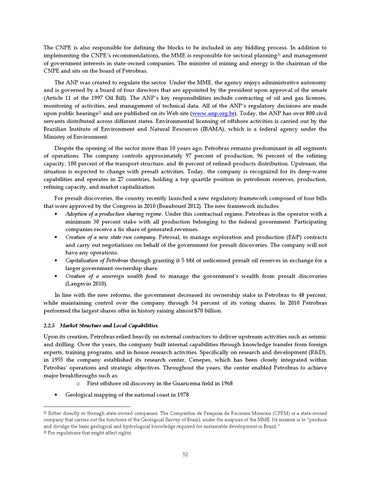The CNPE is also responsible for defining the blocks to be included in any bidding process. In addition to implementing the CNPE’s recommendations, the MME is responsible for sectoral planning 21 and management of government interests in state-owned companies. The minister of mining and energy is the chairman of the CNPE and sits on the board of Petrobras. The ANP was created to regulate the sector. Under the MME, the agency enjoys administrative autonomy and is governed by a board of four directors that are appointed by the president upon approval of the senate (Article 11 of the 1997 Oil Bill). The ANP’s key responsibilities include contracting of oil and gas licenses, monitoring of activities, and management of technical data. All of the ANP’s regulatory decisions are made upon public hearings22 and are published on its Web site (www.anp.org.br). Today, the ANP has over 800 civil servants distributed across different states. Environmental licensing of offshore activities is carried out by the Brazilian Institute of Environment and Natural Resources (IBAMA), which is a federal agency under the Ministry of Environment. Despite the opening of the sector more than 10 years ago, Petrobras remains predominant in all segments of operations. The company controls approximately 97 percent of production, 96 percent of the refining capacity, 100 percent of the transport structure, and 46 percent of refined-products distribution. Upstream, the situation is expected to change with presalt activities. Today, the company is recognized for its deep-water capabilities and operates in 27 countries, holding a top quartile position in petroleum reserves, production, refining capacity, and market capitalization. For presalt discoveries, the country recently launched a new regulatory framework composed of four bills that were approved by the Congress in 2010 (Beaubouef 2012). The new framework includes: Adoption of a production sharing regime. Under this contractual regime, Petrobras is the operator with a minimum 30 percent stake with all production belonging to the federal government. Participating companies receive a fix share of generated revenues. Creation of a new state-run company, Petrosal, to manage exploration and production (E&P) contracts and carry out negotiations on behalf of the government for presalt discoveries. The company will not have any operations. Capitalization of Petrobras through granting it 5 bbl of unlicensed presalt oil reserves in exchange for a larger government-ownership share. Creation of a sovereign wealth fund to manage the government’s wealth from presalt discoveries (Langevin 2010). In line with the new reforms, the government decreased its ownership stake in Petrobras to 48 percent, while maintaining control over the company through 54 percent of its voting shares. In 2010 Petrobras performed the largest shares offer in history raising almost $70 billion. 2.2.5 Market Structure and Local Capabilities
Upon its creation, Petrobras relied heavily on external contractors to deliver upstream activities such as seismic and drilling. Over the years, the company built internal capabilities through knowledge transfer from foreign experts, training programs, and in-house research activities. Specifically on research and development (R&D), in 1955 the company established its research center, Cenepes, which has been closely integrated within Petrobas’ operations and strategic objectives. Throughout the years, the center enabled Petrobras to achieve major breakthroughs such as: o First offshore oil discovery in the Guaricema field in 1968
Geological mapping of the national coast in 1978
Either directly or through state-owned companies. The Companhia de Pesquisa de Recursos Minerais (CPRM) is a state-owned company that carries out the functions of the Geological Survey of Brazil, under the auspices of the MME. Its mission is to “produce and divulge the basic geological and hydrological knowledge required for sustainable development in Brazil.” 22 For regulations that might affect rights. 21
52
